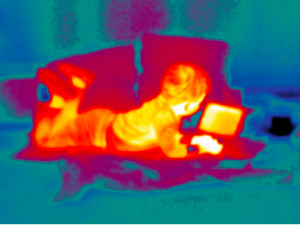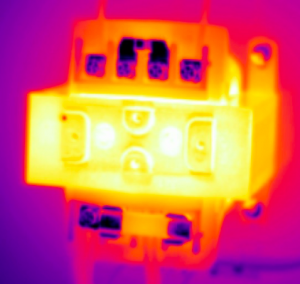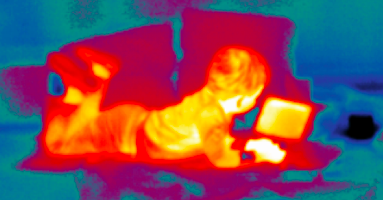What are these infrared inspections I keep hearing about?
Infrared (IR) inspections are being advertised everywhere. Inexpensive hand held thermal scanners are sold in every home depot, as less accurate ineffective point and shoot solutions, and you have most likely read about them in one of your trade magazines. While this technology has been around for a long time, the benefits have only been seen by a few customers. The truth of the matter is, that thermography is a specialized science, but when used by professionals it can predict the future of your electrical equipment.
 FLIR© defines IR thermography as a non-contact way to detect infrared energy and convert it into a thermal image. There are two types of thermography, qualitative and quantitative. Qualitative thermography evaluates differences in thermal energy radiated from similar objects. This is alright for evaluating insulation in walls or ceilings, or locating your children, but it does not take into account the load effects on electrical systems. Electrical and mechanical systems require precise quantitative analysis by knowledgeable technicians to properly evaluate thermal imagery.
FLIR© defines IR thermography as a non-contact way to detect infrared energy and convert it into a thermal image. There are two types of thermography, qualitative and quantitative. Qualitative thermography evaluates differences in thermal energy radiated from similar objects. This is alright for evaluating insulation in walls or ceilings, or locating your children, but it does not take into account the load effects on electrical systems. Electrical and mechanical systems require precise quantitative analysis by knowledgeable technicians to properly evaluate thermal imagery.
You are probably asking how do you apply thermography to electrical systems and will the findings justify the cost? A qualified Thermographer can locate trouble before it becomes an unplanned outage. Do you know of any cases that isn’t worth the expense? We couldn’t think of many either.
 Our thermography team recently performed an evaluation for a client who was having issues with two matched control panels for some vital equipment. The client believed the problem was either a $3,500 controller or a much more expensive equipment repair, both with significant down time. Hoping the problem was the controller the client called us in. We scanned the entire control panel before they operated the equipment and noted temperature anomalies. The equipment was then operated and more data collected. The image to the left is one collected during the inspection showing a transformer operating 125°F above its maximum rating. Our evaluation narrowed the problem down to this transformer. We repaired both systems for about $1,100; much less than anticipated with no costly outage.
Our thermography team recently performed an evaluation for a client who was having issues with two matched control panels for some vital equipment. The client believed the problem was either a $3,500 controller or a much more expensive equipment repair, both with significant down time. Hoping the problem was the controller the client called us in. We scanned the entire control panel before they operated the equipment and noted temperature anomalies. The equipment was then operated and more data collected. The image to the left is one collected during the inspection showing a transformer operating 125°F above its maximum rating. Our evaluation narrowed the problem down to this transformer. We repaired both systems for about $1,100; much less than anticipated with no costly outage.
Many electrical issues result in excessive heat; issues such as overloads or high resistance connections. All electrical systems give off heat proportional to the electrical load on the system; the skill piece is knowing when the heat is a problem vs. a normal operating condition. Heat cannot be seen by the naked eye or measured on a multi-meter. Often the underlying issue goes undetected until the equipment fails or worse a fire results. Anyone who has operated equipment or managed a plant for any time has seen the results of an unplanned outage. We tell all our customers to make IR inspections part of their maintenance programs to plan their outages, because when you don’t electricity will find its own outage.
In the following parts of this series, we will dig into all of the critical factors that make or break a thermographic system evaluation and where it can be used effectively. Items such as what is emissivity and why is it critical to good data? How does spot size ratio affect temperature results? What does the eye see vs. what the IR camera can see? To keep this all relevant we will try to include images from recent projects which will help you to see the spectrum of applications for Thermography.
Have more questions or want to know how to make IR a part of your maintenance program? Contact us and we can help you get started.

